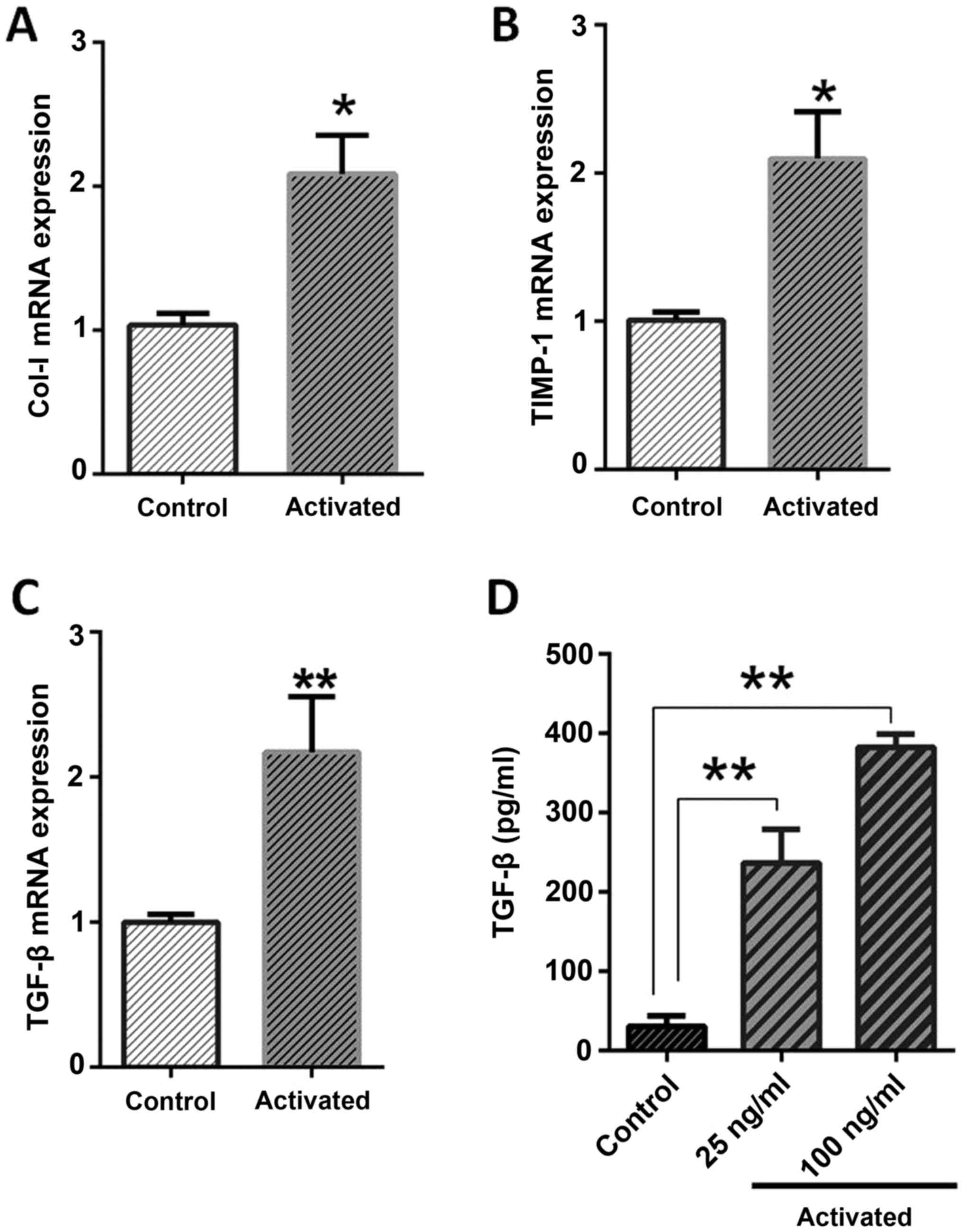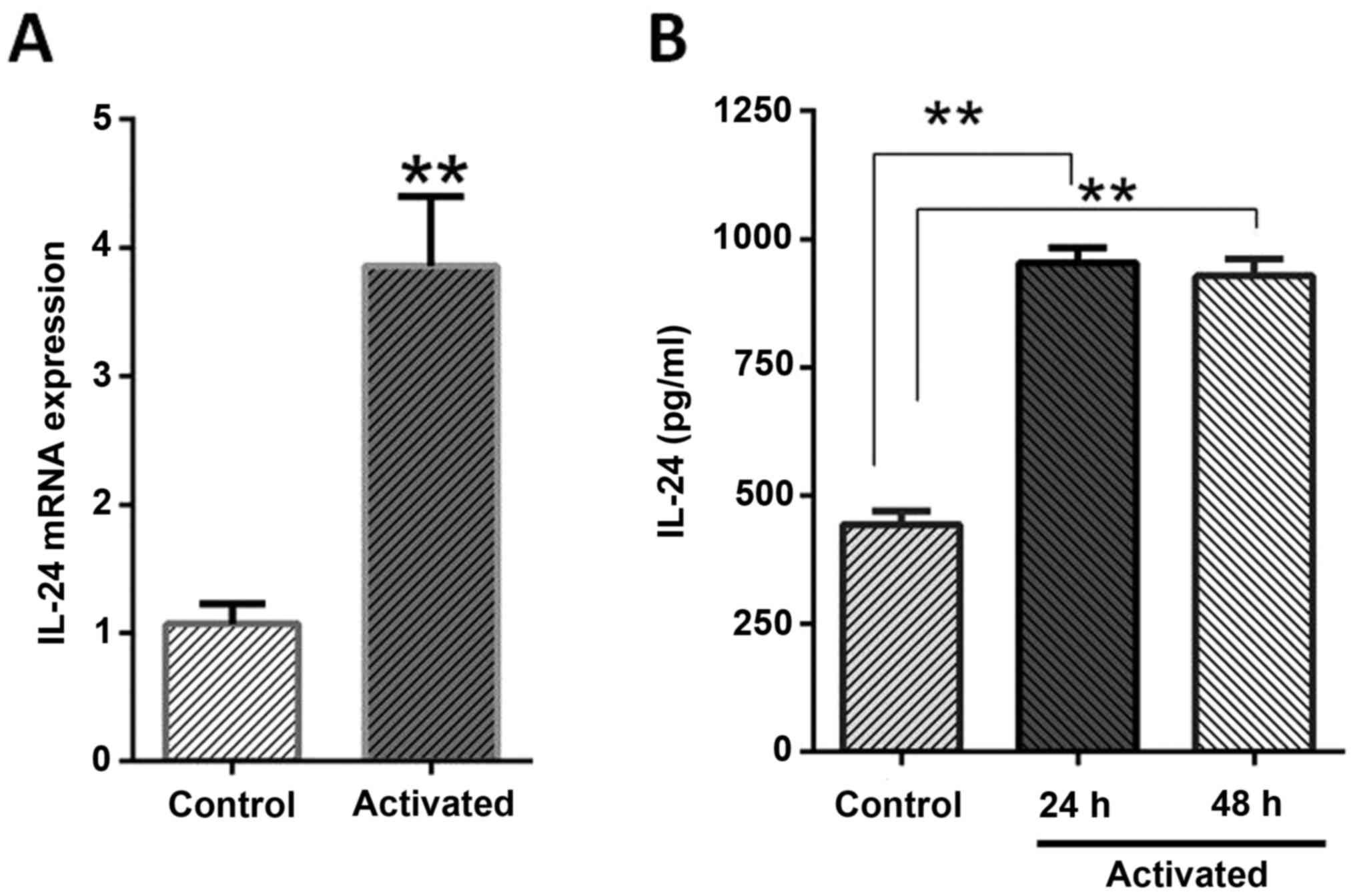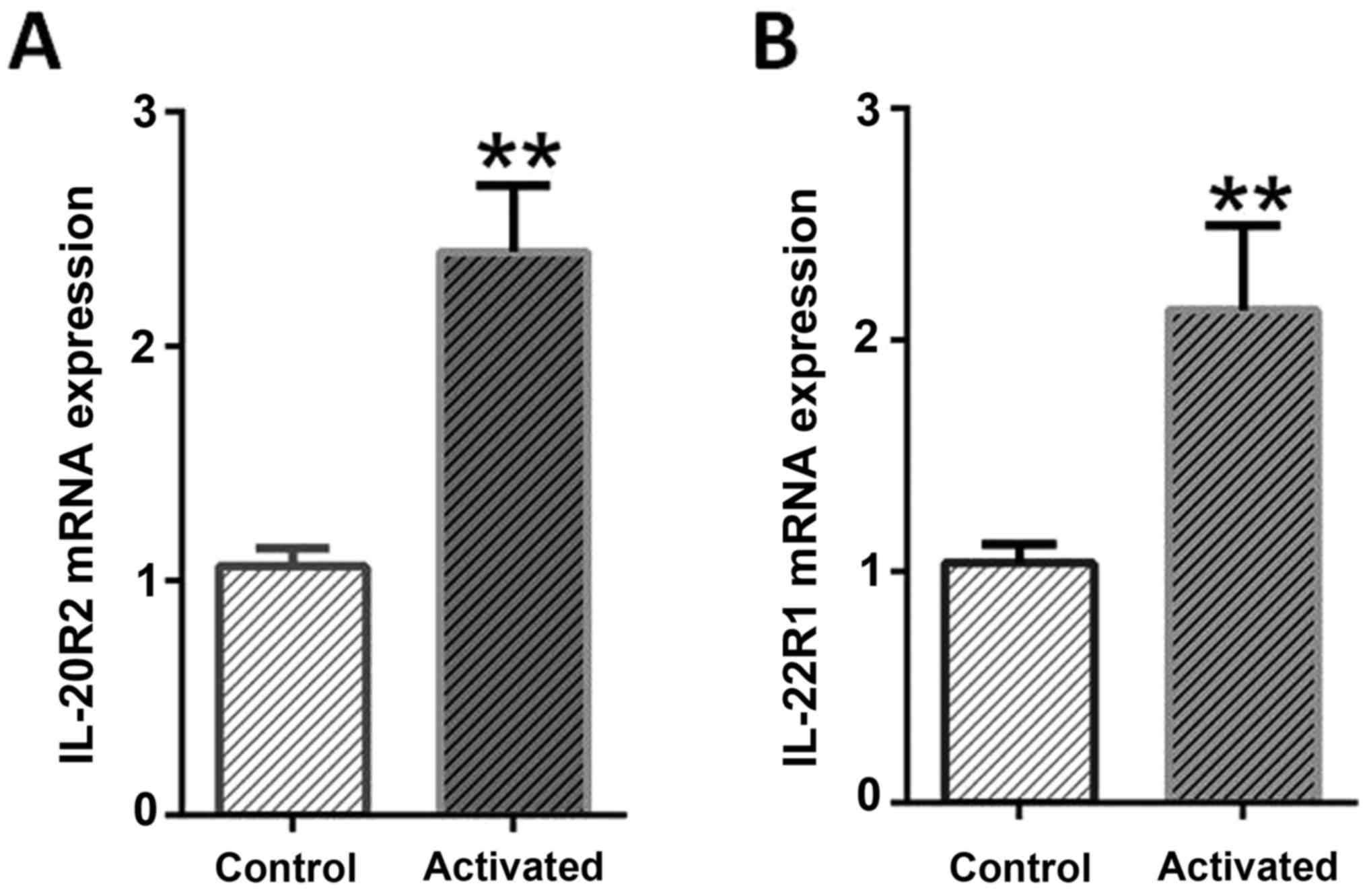|
1
|
Rockey DC: Current and future
anti-fibrotic therapies for chronic liver disease. Clin Liver Dis.
12:939–962. 2008. View Article : Google Scholar : PubMed/NCBI
|
|
2
|
Bataller R and Brenner DA: Liver fibrosis.
J Clin Invest. 115:209–218. 2005. View Article : Google Scholar : PubMed/NCBI
|
|
3
|
Kisseleva T and Brenner DA: Role of
hepatic stellate cells in fibrogenesis and the reversal of
fibrosis. J Gastroenterol Hepatol. 22 Suppl 1:S73–S78. 2007.
View Article : Google Scholar : PubMed/NCBI
|
|
4
|
Jiang JX and Török NJ: Liver injury and
the activation of the hepatic myofibroblasts. Curr Pathobiol Rep.
1:215–223. 2013. View Article : Google Scholar : PubMed/NCBI
|
|
5
|
Loffreda S, Yang SQ, Lin HZ, Karp CL,
Brengman ML, Wang DJ, Klein AS, Bulkley GB, Bao C, Noble PW, et al:
Leptin regulates proinflammatory immune responses. FASEB J.
12:57–65. 1998.PubMed/NCBI
|
|
6
|
Cao Q, Mak KM and Lieber CS: Leptin
represses matrix metalloproteinase-1 gene expression in LX2 human
hepatic stellate cells. J Hepatol. 46:124–133. 2007. View Article : Google Scholar : PubMed/NCBI
|
|
7
|
Yegorov YE, Akimov SS, Hass R, Zelenin AV
and Prudovsky IA: Endogenous beta-galactosidase activity in
continuously nonproliferating cells. Exp Cell Res. 243:207–211.
1998. View Article : Google Scholar : PubMed/NCBI
|
|
8
|
Uygun A, Kadayifci A, Yesilova Z, Erdil A,
Yaman H, Saka M, Deveci MS, Bagci S, Gulsen M, Karaeren N and
Dagalp K: Serum leptin levels in patients with nonalcoholic
steatohepatitis. Am J Gastroenterol. 95:3584–3589. 2000. View Article : Google Scholar : PubMed/NCBI
|
|
9
|
Saxena NK, Saliba G, Floyd JJ and Anania
FA: Leptin induces increased alpha2(I) collagen gene expression in
cultured rat hepatic stellate cells. J Cell Biochem. 89:311–320.
2003. View Article : Google Scholar : PubMed/NCBI
|
|
10
|
Crespo J, Rivero M, Fábrega E, Cayón A,
Amado JA, García-Unzeta MT and Pons-Romero F: Plasma leptin and
TNF-alpha levels in chronic hepatitis C patients and their
relationship to hepatic fibrosis. Dig Dis Sci. 47:1604–1610. 2002.
View Article : Google Scholar : PubMed/NCBI
|
|
11
|
Pestka S, Krause CD, Sarkar D, Walter MR,
Shi Y and Fisher PB: Interleukin-10 and related cytokines and
receptors. Annu Rev Immunol. 22:929–979. 2004. View Article : Google Scholar : PubMed/NCBI
|
|
12
|
Jiang H, Lin JJ, Su ZZ, Goldstein NI and
Fisher PB: Subtraction hybridization identifies a novel melanoma
differentiation associated gene, mda-7, modulated during human
melanoma differentiation, growth and progression. Oncogene.
11:2477–2486. 1995.PubMed/NCBI
|
|
13
|
Sziksz E, Pap D, Lippai R, Béres NJ,
Fekete A, Szabó AJ and Vannay Á: Fibrosis related inflammatory
mediators: Role of the IL-10 cytokine family. Mediators Inflamm.
2015:7646412015. View Article : Google Scholar : PubMed/NCBI
|
|
14
|
Patani N, Jones A Douglas, Mansel R, Jiang
W and Mokbel K: Tumour suppressor function of MDA 7/IL 24 in human
breast cancer. Cancer Cell Int. 10:292010.PubMed/NCBI
|
|
15
|
Wang M, Tan Z, Zhang R, Kotenko SV and
Liang P: Interleukin 24 (MDA-7/MOB-5) signals through two
heterodimeric receptors, IL-22R1/IL-20R2 and IL-20R1/IL-20R2. J
Biol Chem. 277:7341–7347. 2002. View Article : Google Scholar : PubMed/NCBI
|
|
16
|
Huang EY, Madireddi MT, Gopalkrishnan RV,
Leszczyniecka M, Su Z, Lebedeva IV, Kang D, Jiang H, Lin JJ,
Alexandre D, et al: Genomic structure, chromosomal localization and
expression profile of a novel melanoma differentiation associated
(mda-7) gene with cancer specific growth suppressing and apoptosis
inducing properties. Oncogene. 20:7051–7063. 2001. View Article : Google Scholar : PubMed/NCBI
|
|
17
|
Hosseini E, Hosseini SY, Hashempour T,
Fattahi MR and Sadeghizadeh M: Effect of RGD coupled MDA-7/IL-24 on
apoptosis induction in a hepatocellular carcinoma cell line. Mol
Med Rep. 15:495–501. 2017.PubMed/NCBI
|
|
18
|
Yang C, Zeisberg M, Mosterman B, Sudhakar
A, Yerramalla U, Holthaus K, Xu L, Eng F, Afdhal N and Kalluri R:
Liver fibrosis: Insights into migration of hepatic stellate cells
in response to extracellular matrix and growth factors.
Gastroenterology. 124:147–159. 2003. View Article : Google Scholar : PubMed/NCBI
|
|
19
|
Livak KJ and Schmittgen TD: Analysis of
relative gene expression data using real time quantitative PCR and
the 2-ΔΔCq method. Μethods. 25:402–408. 2001.
|
|
20
|
Hosseini SY, Kalantar K, Shahin K, Ghayour
M, Rajabibazl M, Fattahi MR, et al: Comparison of the in vitro
antifibrogenic effects of silymarin, silybin A and 18α glycyrrhizin
on activated hepatic stellate cells. Jundishapur J Nat Pharm Prod
Inpress. e402852016.
|
|
21
|
Pap D, Sziksz E, Kiss Z, Rokonay R,
Veres-Székely A, Lippai R, Takács IM, Kis É, Fekete A, Reusz G, et
al: Microarray analysis reveals increased expression of matrix
metalloproteases and cytokines of interleukin-20 subfamily in the
kidneys of neonate rats underwent unilateral ureteral obstruction:
A potential role of IL-24 in the regulation of inflammation and
tissue remodeling. Kidney Blood Press Res. 42:16–32. 2017.
View Article : Google Scholar : PubMed/NCBI
|
|
22
|
Khanizadeh S, Ravanshad M, Hosseini S,
Davoodian P, Zadeh A Nejati and Sarvari J: Blocking of SMAD4
expression by shRNA effectively inhibits fibrogenesis of human
hepatic stellate cells. Gastroenterol Hepatol Bed Bench. 8:262–269.
2015.PubMed/NCBI
|
|
23
|
Marra F: Leptin and liver fibrosis: A
matter of fat. Gastroenterology. 122:1529–1532. 2002. View Article : Google Scholar : PubMed/NCBI
|
|
24
|
Tian H, Zhang DF, Zhang BF, Li HZ, Zhang
Q, Li LT, Pei DS and Zheng JN: Melanoma differentiation associated
gene-7/interleukin-24 induces caspase-3 denitrosylation to
facilitate the activation of cancer cell apoptosis. J Interferon
Cytokine Res. 35:157–167. 2015. View Article : Google Scholar : PubMed/NCBI
|
|
25
|
Ren X, Hu B and Colletti LM: IL-22 is
involved in liver regeneration after hepatectomy. Am J Physiol
Gastrointest Liver Physiol. 289:G74–G80. 2009.
|
|
26
|
Imaeda H, Nishida A, Inatomi O, Fujiyama Y
and Andoh A: Expression of interleukin-24 and its receptor in human
pancreatic myofibroblasts. Int J Mol Med. 28:993–999.
2011.PubMed/NCBI
|
|
27
|
Gao Y, Ren H, Meng F, Li J, Cheung E, Li
H, Zhao J, Liu H, Liu Z and Zhang M: Pathological roles of
interleukin-22 in the development of recurrent hepatitis C after
liver transplantation. PLoS One. 11:e01544192016. View Article : Google Scholar : PubMed/NCBI
|
|
28
|
Hu CW, Yin GF, Wang XR, Ren BW, Zhang WG,
Bai QL, Lv YM, Li WL and Zhao WQ: IL-24 induces apoptosis via
upregulation of RNA-activated protein kinase and enhances
temozolomide-induced apoptosis in glioma cells. Oncol Res.
22:159–165. 2014. View Article : Google Scholar : PubMed/NCBI
|
|
29
|
Shefler I, Pasmanik-Chor M, Kidron D,
Mekori YA and Hershko AY: T cell-derived microvesicles induce mast
cell production of IL-24: Relevance to inflammatory skin diseases.
J Allergy Clin Immunol. 133:217–224. 2014. View Article : Google Scholar : PubMed/NCBI
|
|
30
|
Kunz S, Wolk K, Witte E, Witte K, Doecke
WD, Volk HD, Sterry W, Asadullah K and Sabat R: Interleukin
(IL)-19, IL-20 and IL-24 are produced by and act on keratinocytes
and are distinct from classical ILs. Exp Dermatol. 15:991–1004.
2006. View Article : Google Scholar : PubMed/NCBI
|
|
31
|
Mirzaei MH and Esmaeilzadeh A:
Overexpression of MDA-7/IL-24 as an anticancer cytokine in gene
therapy of thyroid carcinoma. J Med Hypotheses Ideas. 8:7–13. 2014.
View Article : Google Scholar
|
|
32
|
Jiang H, Su ZZ, Lin JJ, Goldstein NI,
Young CS and Fisher PB: The melanoma differentiation associated
gene mda-7 suppresses cancer cell growth. Proc Natl Acad Sci USA.
93:9160–9165. 1996. View Article : Google Scholar : PubMed/NCBI
|
|
33
|
Xiao CW, Xue XB, Zhang H, Gao W, Yu Y,
Chen K, Zheng JW and Wang CJ: Oncolytic adenovirus-mediated
MDA-7/IL-24 overexpression enhances antitumor activity in
hepatocellular carcinoma cell lines. Hepatobiliary Pancreat Dis
Int. 9:615–621. 2010.PubMed/NCBI
|
|
34
|
Sarkar D, Su ZZ, Lebedeva IV, Sauane M,
Gopalkrishnan RV, Dent P and Fisher PB: mda-7 (IL-24): Signaling
and functional roles. Biotechniques. 33:30–39. 2002.
|
|
35
|
Kirsch S: The effect of cytokines of the
Interleukin-10-family on cutaneous wound healing. Freie
Universität; Berlin: 2013, (In German).
|
|
36
|
Sakurai N, Kuroiwa T, Ikeuchi H, Hiramatsu
N, Maeshima A, Kaneko Y, Hiromura K and Nojima Y: Expression of
IL-19 and its receptors in RA: Potential role for synovial
hyperplasia formation. Rheumatology (Oxford). 47:815–820. 2008.
View Article : Google Scholar : PubMed/NCBI
|












